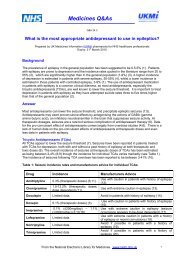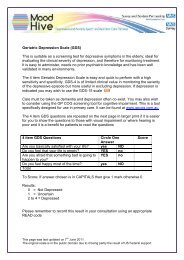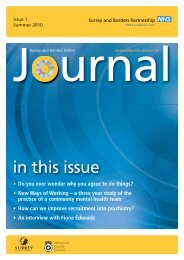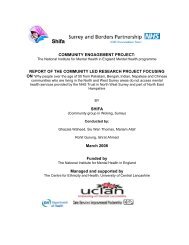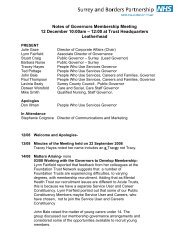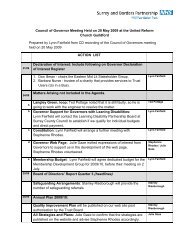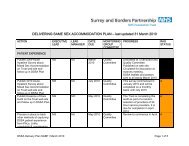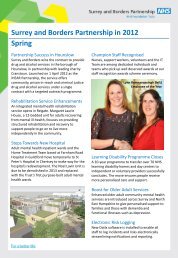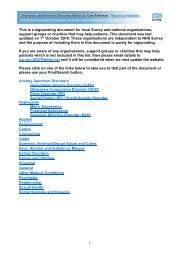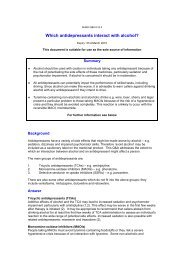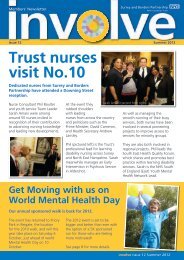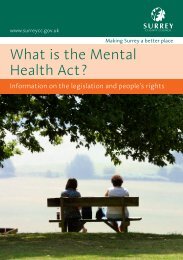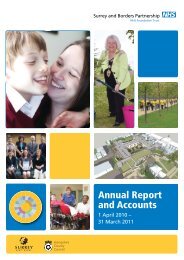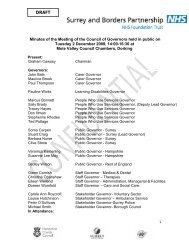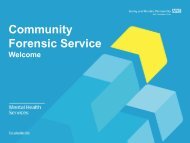DVLA "at a glance" fitness to drive - Heart Rhythm UK
DVLA "at a glance" fitness to drive - Heart Rhythm UK
DVLA "at a glance" fitness to drive - Heart Rhythm UK
Create successful ePaper yourself
Turn your PDF publications into a flip-book with our unique Google optimized e-Paper software.
-The applicant or licence holder must notify <strong>DVLA</strong> unless st<strong>at</strong>ed otherwise in the text<br />
AT A GLANCE BOOKLET - INTRODUCTION<br />
Revised September 2008<br />
This public<strong>at</strong>ion summarises the n<strong>at</strong>ional medical guidelines of <strong>fitness</strong> <strong>to</strong> <strong>drive</strong> and is available <strong>to</strong> doc<strong>to</strong>rs<br />
and health care professionals. It can be found specifically through EMIS, INPS secure GP Medical<br />
Inform<strong>at</strong>ion Systems and NHSpurchasing.co.uk. It is also publicly available on the <strong>DVLA</strong> website <strong>at</strong><br />
www.dvla.gov.uk. Hard copies of the booklet are available on request for a fee of £4.50 (cheques made<br />
payable <strong>to</strong> <strong>DVLA</strong> Swansea) from Drivers Medical Group, DMDG, <strong>DVLA</strong>, Swansea SA99 1DF. Telephone<br />
01792 782336 (answer machine for Medical Professionals Only).<br />
The inform<strong>at</strong>ion in the booklet is intended <strong>to</strong> assist doc<strong>to</strong>rs in advising their p<strong>at</strong>ients whether or not they should<br />
inform <strong>DVLA</strong> of their medical condition and wh<strong>at</strong> the outcome of medical enquiries is likely <strong>to</strong> be.<br />
In the interests of road safety, those who suffer from a medical condition likely <strong>to</strong> cause a sudden disabling event<br />
<strong>at</strong> the wheel or who are unable <strong>to</strong> safely control their vehicle from any other cause, should not <strong>drive</strong>.<br />
• Compil<strong>at</strong>ion of the Guidelines.<br />
These guidelines represent the interpret<strong>at</strong>ion and applic<strong>at</strong>ion of the law in rel<strong>at</strong>ion <strong>to</strong> <strong>fitness</strong> <strong>to</strong> <strong>drive</strong> following<br />
advice from the Secretary of St<strong>at</strong>e’s Honorary Medical Advisory Panels. The Panels consist of doc<strong>to</strong>rs eminent in<br />
the respective fields of Cardiology, Neurology, Diabetes, Vision, Alcohol/Substance Abuse and Psychi<strong>at</strong>ry<br />
<strong>to</strong>gether with lay members.<br />
The Panels meet twice yearly and the standards are reviewed and upd<strong>at</strong>ed where indic<strong>at</strong>ed. This booklet is,<br />
therefore, only accur<strong>at</strong>e <strong>at</strong> the time of public<strong>at</strong>ion.<br />
It is also emphasised th<strong>at</strong> this booklet is for use as guidance only. Whilst it provides some idea of the anticip<strong>at</strong>ed<br />
outcome of a medical enquiry, the specific medical fac<strong>to</strong>rs of each case will be considered before an individual<br />
licensing decision is reached.<br />
• The Legal basis for the medical standards.<br />
The Secretary of St<strong>at</strong>e for Transport acting through the medical advisers <strong>at</strong> the Drivers Medical Group, <strong>DVLA</strong>, has the<br />
responsibility <strong>to</strong> ensure th<strong>at</strong> all licence holders are fit <strong>to</strong> <strong>drive</strong>.<br />
The legal basis of <strong>fitness</strong> <strong>to</strong> <strong>drive</strong> lies in the 2 nd EC Directive on driving licences (91/439/EEC), which came in<strong>to</strong> effect<br />
in the <strong>UK</strong> in January 1997, the Road Traffic Act 1988 and the Mo<strong>to</strong>r Vehicles (Driving Licences) Regul<strong>at</strong>ions 1999.<br />
Section 92 of the Road Traffic Act 1988 refers <strong>to</strong> prescribed, relevant and prospective disabilities.<br />
• A prescribed disability is one th<strong>at</strong> is a legal bar <strong>to</strong> the holding of the licence. Certain st<strong>at</strong>u<strong>to</strong>ry conditions, defined<br />
in regul<strong>at</strong>ion, may need <strong>to</strong> be met. An example is epilepsy.<br />
• A relevant disability is any medical condition th<strong>at</strong> is likely <strong>to</strong> render the person a source of danger while driving.<br />
An example is a visual field defect.<br />
• A prospective disability is any medical condition, which, because of its progressive or intermittent n<strong>at</strong>ure may<br />
develop in<strong>to</strong> a prescribed or relevant disability in the course of time. An example is insulin tre<strong>at</strong>ed diabetes. A<br />
<strong>drive</strong>r with a prospective disability may normally only hold a driving licence subject <strong>to</strong> medical review in one, two<br />
or three years.<br />
Sections 92 and 93 of The Road Traffic Act 1988 also cover <strong>drive</strong>rs with physical disabilities who require adapt<strong>at</strong>ions<br />
<strong>to</strong> their vehicle <strong>to</strong> ensure its safe control. The adapt<strong>at</strong>ions required are now coded and entered on the licence. (See<br />
Appendices 1 & 2 on pages 44 & 45).<br />
2



